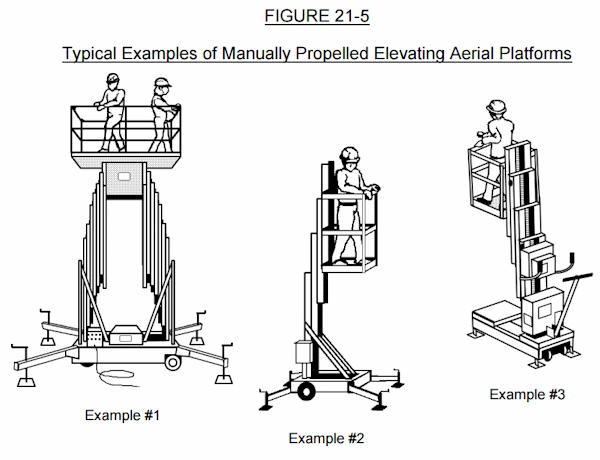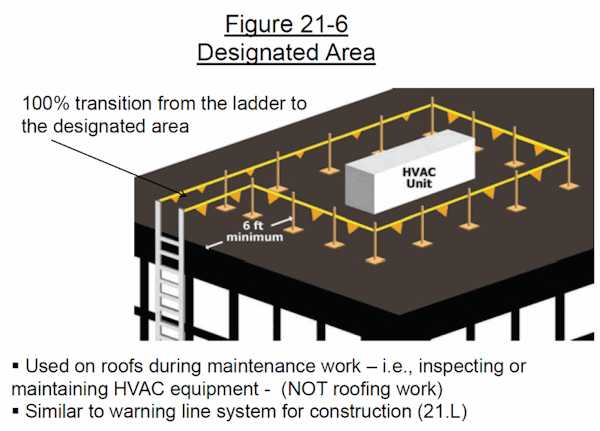21.K.05 Aerial Work Platforms:
Boom Supported Platforms (per ANSI A92.5) and Vehicle Mounted Rotating and Elevating Aerial Devices (per ANSI A92.2).
Aerial Work Platform

- Workers must be anchored to the basket or bucket in accordance with manufacturer's specifications and instructions (anchoring to the boom may only be used when allowed by the manufacturer and permitted by the CP).
- Lanyards used must be sufficiently short to prohibit worker from climbing out of basket.
- Lanyards with built-in shock absorbers are acceptable.
- Self-retracting devices are not acceptable.
- Tying off to an adjacent pole or structure is not permitted unless a safe device for 100% tie-off is used for the transfer.
21.K.06 Manually Propelled Elevating Work Platforms (per ANSI/SIA A92.3).
> See Section 22.C.06 for Mobile Scaffolds.
- The platform must be equipped with standard guardrails.
- If the platform is equipped with anchorages meeting the ANSI Z359, a restraint system must be used in addition to the guardrails.
- Lanyards used with the restraint system must be sufficiently short to prohibit workers from climbing out of, or being ejected from the platform.
- Lanyards with built-in shock absorbers are acceptable.
- Self retracting devices are not acceptable.
- The platform must not be occupied when moved and at no time will workers be allowed to climb on or over the guardrails. > See Figure 21-5.
21.L Warning Line System (WLS).
21.L.01 A WLS may ONLY be used on floors, or flat or low-sloped roofs (between 0-18.4º or less than 4:12 slope) during construction work and must be erected around all sides of the work area.
21.L.02 A WLS must consist of wires, rope or chains 34-39 in (0.9-1.0 m) high with supporting stanchions. WLS must be flagged at not more than 6 ft (1.8 m) intervals with a high visibility material.
21.L.03 The wire, rope or chains must have a minimum tensile strength of 500 lbs (2.2 kN) and after being attached to the stanchions must be capable of supporting without braking, the loads applied to the stanchions.
21.L.04 Stanchions must be capable of resisting without tipping a force of 16 lbs (71 N) applied horizontally against the stanchions 30 in (76.2 cm) above the walking/working surface, perpendicular to the warning line and in the direction of the roof floor or platform edge. The line consisting of wire rope or chains must be attached at each stanchion in such a way that the pulling on one section of the line will not result in a slack being taken up in adjacent sections before the stanchion tips over.
21.L.05 Working within the WLS does not require fall protection. No worker must be allowed in the area between the roof or floor edge and the WLS without fall protection. Fall protection is required when working outside the WLS.
21.L.06 Roofing Work.
- For roofing work on flat roofs, the WLS must be erected not less than 6 ft (1.8 m) from the edge.
- When roofing work is conducted on low sloped roofs (less than 4:12), or when using mechanical equipment or when work is performed by other trades (i.e., mechanical contractor performing work on equipment located on roofs, etc), the WLS must be erected not less than 15 ft (4.5 m) from the unprotected side or edge.
21.L.07 A Designated Area is used as a fall protection method during maintenance work (i.e., inspecting or maintaining HVAC equipment) on roofs. The requirement for the Designated Area is identical to WLS. In addition, a 100% transition is required from the access point on the roof to the Designated Area. > See Figure 21-6.
Knowledge Check Choose the best answer for the question.
21-12. Which practice is allowed when working on manually propelled elevating work platforms?
You forgot to answer the question!


